 | |
 | |
 | |
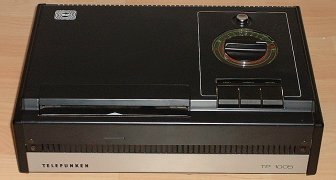 | |
 | |||||||
| |||||||
 |  | ||||||
 | FORMAT: TeD | ||||||
Date: 1974 Price: £400 [2005: £2790] 46x32x16cm | |||||||
 |  |
|
| |||||||||||||||||||||||||||||||
| This is the only model of TeD machine which I know of (although I've seen pictures of similar ones in different colours). It is satisfyingly simple, with the disc slot on the left and the control panel on the top. The main control is a large rotary knob, which is used to both load the disc and to display (or select) the part of the disc which is playing. | |
| To load a disc, it is inserted still in its protective sleeve, and the knob turned half way round from "Start" to "Play". What is happening inside is quite surprising: the flexible disc is pulled out of the sleeve by rollers, and fed down and around into the play position, turning completely over as it folds around -- more like paper through a printer than a record on a turntable! Inserting the disk in its sleeve | 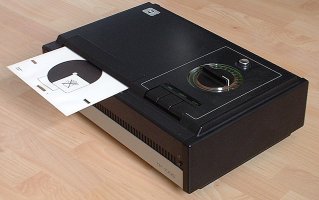 |
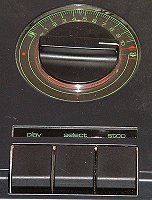 | When the disk is properly loaded, a light goes out and the Play button can be pressed. As the disk plays, the knob rotates to indicate the time, until it finally reaches the end and stops. Then the knob is turned back all the way to Start, which returns the disk to its sleeve and releases it so that it can be pulled out. The three control keys are "Play", "Select" and "Stop". Stop and Play are self-explanatory; Select is used to move to a particular point in the recording, by turning the control knob, and also to repeat the last 10 seconds. |
| The player's cover and disk loading carriage both raise up. In contrast to today's machines, the owner was expected to carry out some basic servicing, like changing and adjusting the stylus. And, although the manual doesn't mention it, I also suspect that they would have to open the machine from time to time to remove a jammed disk... The player with the cover and disk slot lifted. At the back you can see the rollers which pull the disc out, round the back, under the stylus carriage and down onto the black play surface. This loading mechanism is driven directly by the loading/control knob. | 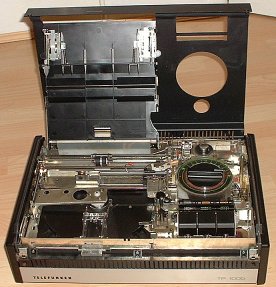 |
 | The TED system uses a diamond stylus to pick up the signal from a spiral groove, like a normal LP record. However, since the disc spins at 1500 rpm, TED uses a cushion of air rather than a turntable to support it; it spins so fast that it "flies" unsupported. The stylus movement is mechanically linked to the rotation, rather than being guided by the groove. This allows the grooves to be very fine -- 13 times finer than LP record grooves. The signal is frequency modulated and encoded as variations in the depth of the groove (unlike audio records, where the signal is side-to-side). |
| One incredible feature is that the needle is automatically re-sharpened after each play. A spinning disk, presumably covered in diamond-encrusted grooves, re-grinds the tip; the manual says that a needle should last for more than 500 plays. Interestingly, it also says that "...unlike records, a worn needle cannot damage the disk." The stylus head, with the sharpening disk visible behind it. The black knob is the equivalent of a VCR's tracking knob. | 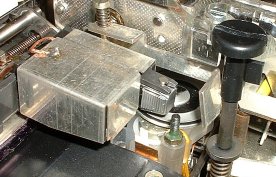 |
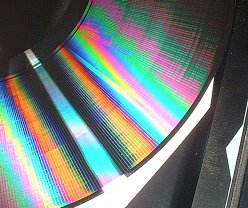 | TED disks are single sided, and CAV - constant angular velocity - containing one frame per revolution. So, the scan lines all line up and can be seen as radial patterns on the surface. A close-up of the playing surface. Like LaserDisks and CDs, but unlike audio records, the surface variations are small enough to cause "interference fringe" rainbow colours |
| They are flexible, and the promotional literature makes great play of their cheapness and the ability to insert them into magazines or send them through the post. But the maximum playing time of 10 minutes is clearly a major drawback; I've seen films produced as box-sets of 6 or 8 discs, but the frequent changes would have made the movie experience less than satisfying! A multi-disc player was planned, but as far as I know never made it to market. Probably because of the short playing time, the format made very little impact. Players are reasonably common in Germany (which is where mine came from), but no-one in Britain seems to have heard of it -- even though it was theoretically available here. (In 1980 there was, apparently, "one institutional user" in the UK, possibly a hospital using it to store medical images). |